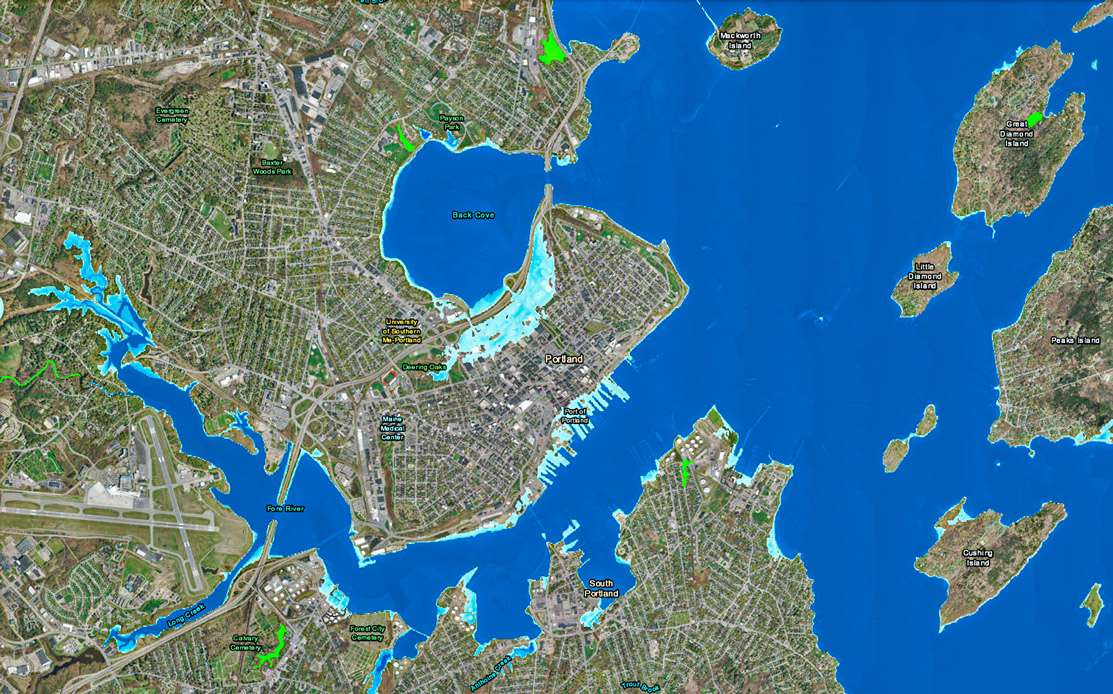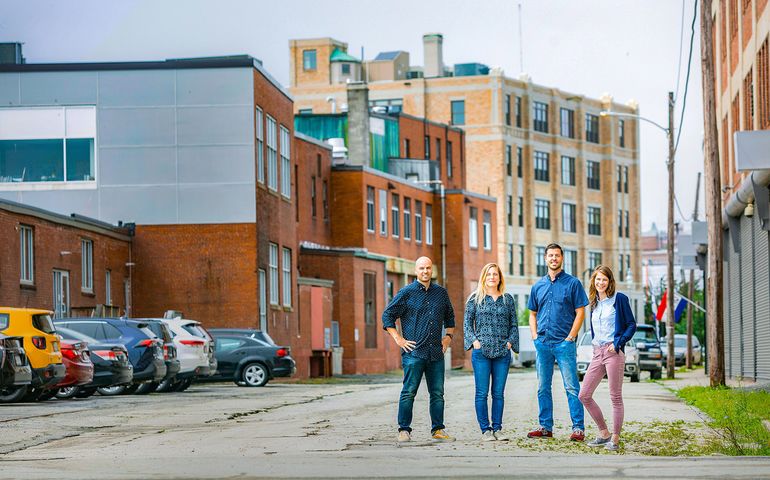
Future-proofing development: Designers are ready for climate change
 Photo / Tim Greenway
Left to right, Nick and Caitlin Aceto, founding partners of Aceto Landscape Architects + Urbanists; Seth Kimball, principal; and Charlotte Evanofski, landscape architect, in Portland’s Bayside neighborhood.
Photo / Tim Greenway
Left to right, Nick and Caitlin Aceto, founding partners of Aceto Landscape Architects + Urbanists; Seth Kimball, principal; and Charlotte Evanofski, landscape architect, in Portland’s Bayside neighborhood.
Two large renderings share space next to each other in the Portland office of Aceto Landscape Architects + Urbanists. One is of the 500-acre landscape design for The Downs mixed-use project in Scarborough, which is in the first phase of development.
The other is the design that won Portland’s Bayside Adapt Challenge two years ago.
The Downs is underway. The Bayside design, which includes removing Interstate 295, will likely never become a reality. But both are basically the same, say Nick and Caitlin Aceto, founding partners of the firm.
“This is the way we work,” says Nick Aceto.
While much climate change discussion revolves around slowing its pace, those who design buildings, landscapes and urban areas are also working out how to adapt to inevitable changes brought on by warmer temperatures, more severe weather and rising sea levels.
“I think anyone who’s experienced one of the king tide events on the peninsula realizes the sea is rising,” says Jeff Levine, Portland’s director of planning and urban development. Particularly in the Bayside neighborhood, along the Back Cove, those tides often lead to extensive flooding on Marginal Way and other low-lying areas of Bayside.
The contest won by Aceto in 2017 was, in part, to bring public attention to the need for adaptive planning.
Solutions, adaption the same
Designing to adapt is nothing new to landscape and building architects.
At Kaplan Thompson’s office on Exchange Street in Portland, principal Jesse Thompson spreads photos of the Parris Terraces condominium development in Bayside on the table.
The 23-unit development, designed to bring affordable workforce housing to the city, is energy efficient, and also designed to mitigate storm runoff. It’s an example of modern building with a smaller impact that will also withstand environmental change.
“The same solutions that will help stop climate change, or lessen its bad effects, are the ones that will help us adapt,” says Thompson.
“What does climate change look like?” he says. “What we have now, only more of it. More flooding, more ice storms, more hot days. The road outside Whole Foods [in Bayside] floods maybe five times a year. In the future, it’ll flood 50 times. What’s now nuisance flooding will be more than a nuisance.”

Bayside floods when storm runoff coming downhill meets the water from high tides in the storm system. The U.S. Environmental Protection Agency mandates storm runoff mitigation in buildings.
Thompson points to the landscaping at Parris Terraces foundation. The native plants help absorb the runoff, and subtle grates are embedded in the ground to catch the water and recirculate it.
The energy efficiency of buildings like Parris Terraces, and the passive house Bayside Anchor multi-family building that Kaplan Thompson also designed, lessen the impact to the environment. But they also provide more efficient heat and cooling, and can keep indoor temperatures moderate during power outages — temperatures in a passive house building won’t go below 45 degrees if the power’s out.
Those systems also cool buildings in the summer.
“Having to keep a building cool is a new thing for Maine,” he says. “But the building will be around for 50 years, and we need solutions that can handle rising temperatures.”
Thinking holistically
The Aceto design that won the 2017 Bayside Adapt Challenge shows a phased approach though 2050 that includes removal of Interstate 295. Instead there’s a park along the Back Cove that would lessen the flooding impact.
The design also brings back Mill Pond and the stream that links it to the cove, where the Forest Avenue east side northbound ramp to Interstate 295 is. The pond was filled in more than a century ago. The return to natural wetlands would help absorb some of the storm surge that now spreads across pavement.
The rendering also shows where buildings can fill in empty lots or paved surface parking. The design is built on the same principles they use every day.
“It’s a balanced approach,” says Caitlin Aceto. “It’s about more than ‘Where’s the water going?’ It’s ‘How can we infill development, what can we do with transportation and redundant infrastructure?”
Increasing urban density will allow more people to be closer to where they work, attend school, get services and shop, lessening the impact on the environment and people’s dependence on infrastructure, the Acetos say.
“The biggest fallacy in Portland is that it’s ‘full,’” Nick says. All he and his colleagues see are empty spaces that aren’t being used well. “It’s about shifting the land-use paradigm.”
Caitlin adds, “It’s thinking holistically. There’s a ripple-down effect.”
Design that focuses on today should also be asking what effect it will have in 50 years, she says.
Seth Kimball, a principal at Aceto, adds, “We have the unique opportunity to get ahead of it. We can decide what’s important. We can decide how to adapt to our future in smart ways.”
Stressing the bottom line
Portland and South Portland are also focusing on adaption, collaborating on a plan that’s expected to be completed next year. A preliminary action plan published last fall cites the opportunity to “develop more robust adaptation strategies” that may include resilience-based ordinances, design standards and building codes that will connect adaptation to growth planning.
Levine says rather than requiring developers to change, the city is looking at what incentives can be provided. “We want to say, ‘If you build an adaptive building, if you put the floor plate where it won’t get wet in 50 years, there are incentives for that.’
“People are interested in doing the right thing,” he says, but they’re also business people who have to focus more on what the building brings to the immediate future, not what will happen in 50 years. “There needs to be a balance,” he says.
The Acetos and Thompson say they rarely discuss adaptability with clients.
Instead of discussing how a design is “good for the planet,” Nick Aceto says, “we convince them to do it because it’s good for their bottom line and their business plan.”
Native plantings, minimal turf, slowing storm water at the source, are all things that make financial and long-term maintenance sense, he says.
Landscaping that has less impact on the environment is almost always more economically viable and more efficient, he says.
Thompson says energy efficiency, too, is a better economic choice. It’s about 3% to 4% more expensive to build a passive house building than a traditional one, down from 10% a few years ago. But passive house design cuts energy costs by 90%.
All of Kaplan Thompson’s singlefamily home designs have a conduit to run electricity to the roof for solar panels and to the garage for an electric car charger, even if the homeowner isn’t installing solar or driving an electric car.
“It’s future-proofing,” Thompson says. “It’s 50 bucks to put it in when the house is being built, and cutting open a wall to put it in after is going to cost thousands.”
Solar energy can be stored in the electric car charging battery, and can run the house electric system in a power outage.
“People are very worried they can’t afford the good stuff,” Thompson says. Fear of bad weather events is also a “bad motivator.”
“We talk about the good things, we talk about making buildings more comfortable, making them safer.” Energy efficient buildings, for instance, have ventilation that brings in fresh air all day, helping ease or prevent illness. “There’s filtered clean air available in every room, and it just happens that it’ll heat the building, too.”
“Think of it as high-quality building design,” he says. “There’s good fresh air, good insulation, and they are good, tough buildings.”
Caitlin Aceto says designers are in a unique position. “Not all of our clients subscribe to, or care about, climate change. But we’re in a position to make a difference.”










0 Comments